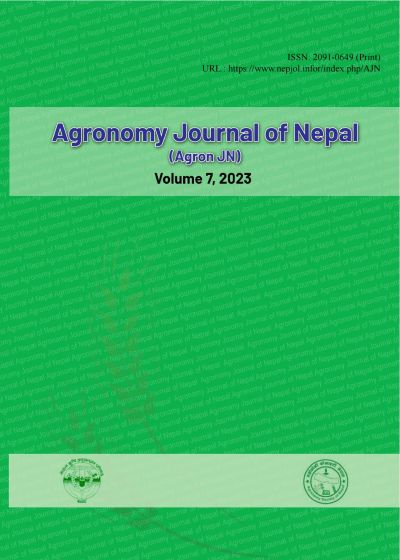Growth and Productivity of Cowpea (Vigna unguiculata L.) in Response to Seed Priming and Different Levels of Phosphorus
DOI:
https://doi.org/10.3126/ajn.v7i1.62052Keywords:
Calcium nitrate, cowpea, biological yield, harvest index, growthAbstract
Acidic soil generally has lower availability of phosphorus. Grain legumes respond positively to higher levels of phosphorus in acidic soil. Seed priming also enhances growth of the crops by activating various metabolic processes in plants. A field experiment was carried out to determine the influence of seed priming and phosphorus levels on growth and productivity of cowpea at Bhojad, Chitwan, Nepal. The experiment plot was laid out in two factorial randomized complete block design with three replications and the planting was done in spring season of 2022. The treatment consisted of two levels of seed priming (no priming and priming with 0.2 % Ca (NO3)2 for 24 hours) and four levels of P2O5 (20,30,40 and 60 kg ha-1). The variations in different parameters of cowpea due to seed priming were significant (P < 0.05). Primed seed produced the highest grain yield (1.25 t ha-1), which was followed by non-primed seeds (1.16 t ha-1). Similar significant (p<0.001) differences in yield and yield-attributing (no. of grains/pods, test weight, biological yield, grain yield and harvest index) traits were found at different levels of P2O5, with the highest grain yield (1.44 t ha-1) was obtained when applied with 40 kg P2O5 ha-1. Significant (p<0.001) variations in grain yield were found as a result of the interaction between priming and P2O5 levels. The combination of priming and 40 kg P2O5 ha-1 produced the highest grain yield (1.51 t ha-1). The results showed that the use of primed seed with 40 kg P2O5 ha-1 would be beneficial for the farmers in the Terai region of Nepal.
Downloads
Downloads
Published
How to Cite
Issue
Section
License
Copyright (c) 2023 Agronomy Society of Nepal (ASoN)

This work is licensed under a Creative Commons Attribution-NonCommercial 4.0 International License.
ASON permits for free use, distribution and reproduction in any medium if the original work is properly cited and not used for commercial purposes.




